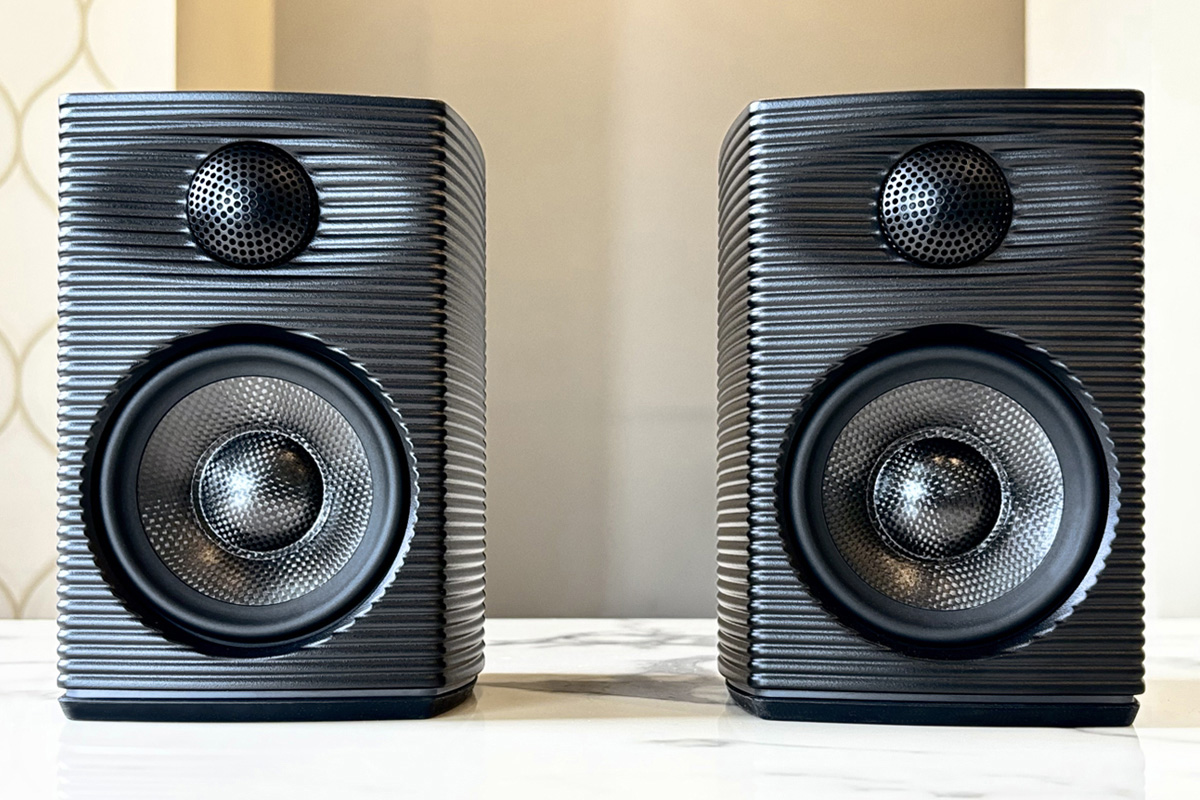FiiO has made quite a name for itself in headphone-audio circles thanks to the quality of its well-priced portable electronics, which include DACs, DAPs, headphone amplifiers, and Bluetooth transmitters and receivers. Recently, the Chinese brand has been expanding its product offerings into other areas, such as headphones, turntables, and active loudspeakers.
Released in May 2023, FiiO’s SP3 was the first product in its SP loudspeaker line. Intended to deliver convincing computer-sourced sound for gaming and home-office applications, this compact, straightforward desktop speaker system offered two analog stereo inputs. The FiiO SP3 BT (US$349, CA$499.99, £319, €379) builds on this platform by adding not just the ability to receive wireless Bluetooth audio, but also USB, optical, and coaxial inputs to its feature set. Those upgrades make the product flexible enough to get picked up on Simplifi’s radar.
FiiO clearly intends the SP3 BT to work alongside its award-winning R7 and R9 desktop streaming players, which are serious devices, both sharing complementary looks and dimensions with the SP3 speakers. They create a cohesive aesthetic when combined as a complete desktop system.
But the speakers can easily be paired with any streaming preamp, resulting in an unobtrusive system not just for the desktop, but for any modern minimalist living space that calls for compact hi-fi. With these little active speakers, FiiO aims to combine audiophile-grade sound quality with a tiny footprint, while offering the flexibility to connect source devices through wired and wireless means. Can this diminutive system actually deliver?
Inside and out
The FiiO SP3 BT system consists of a pair of two-way active speakers, each measuring 6.4″H × 4.7″W × 5.2″D. They have a reassuring heft that suggests premium construction despite their compact dimensions—the primary speaker weighs 4.6 pounds, and the secondary speaker weighs 4.1 pounds. The enclosures are a standout feature, boasting an all-aluminum-alloy chassis that’s been liquid die-cast for enhanced resonance control, something I’ve never seen at this price point before.
The speakers are available in either black or white finishes, with a purposeful industrial design; the cabinets feature clean lines with gently rounded edges and unusual horizontal ribbing over their entire surface. A protective mesh grille for the tweeter is incorporated into the baffle, though the midrange-woofer’s cone is left permanently exposed.

The driver complement consists of a 3.5″ carbon-fiber midrange-woofer paired with a 1″ silk-dome tweeter. The crossover frequency is set at 3.4kHz, a relatively high point that places more of the critical midrange responsibilities on the midrange-woofer. This means that the crossover should have minimal impact on vocals or speech, which helps with natural reproduction of this critical region.
The carbon-fiber woofer construction deserves some attention. Each individual carbon-fiber strand is just 0.007mm thick, approximately the width of a human hair. These fibers are intricately braided together, creating a diaphragm that is simultaneously lightweight, rigid, and strong. The light weight enables rapid response times, while the rigidity minimizes unwanted secondary vibrations and non-linear distortion. FiiO has implemented asymmetrical magnetic circuits in the woofer design, with an auxiliary magnet added to the center to strengthen the magnetic field. This enhancement is intended to reduce non-linear distortion across the entire frequency band, particularly important given the woofer’s extended frequency range.
The 1″ silk-dome tweeter features a copper-plated aluminum KSV voice coil designed for accurate high-frequency reproduction. KSV is a type of voice-coil-former material, known for its durability and resistance to high temperatures. The tweeter is mounted in a molded waveguide, which is recessed into the front baffle for controlled dispersion; the horizontal ridges reportedly help to diffuse sound effectively throughout the listening space. These design considerations are important for maintaining tonal balance when listening off-axis.
Another distinctive engineering feature is the incorporation of a double-diffused S-shaped porting tube. This design allows the compact cabinets to reproduce deeper bass than their size would suggest. The S-shaped path increases the effective length of the port while maintaining the speaker’s compact envelope, deepening the bass extension of the 3.5″ driver. Amplification is provided by TI class‑D amplifiers delivering 30W to each woofer and 10W to each tweeter, for a total system output of 80W.
The SP3 BT is designed with desktop placement in mind. The system includes two sets of silicone bases, each having a 4.5″ × 5.25″ footprint. One set positions the speakers flat (0-degree elevation), while the other provides a 7-degree upward tilt. This is intended to allow users to optimize the throw angle for nearfield listening at a desk, so the tweeters are aimed closer to ear level. The silicone construction of these stands also provides some isolation from the underlying surface, effectively acting as vibration absorbers. However, there is nothing provided to securely attach them to the speakers, which got to be increasingly annoying each time I repositioned a speaker and had its base come off.
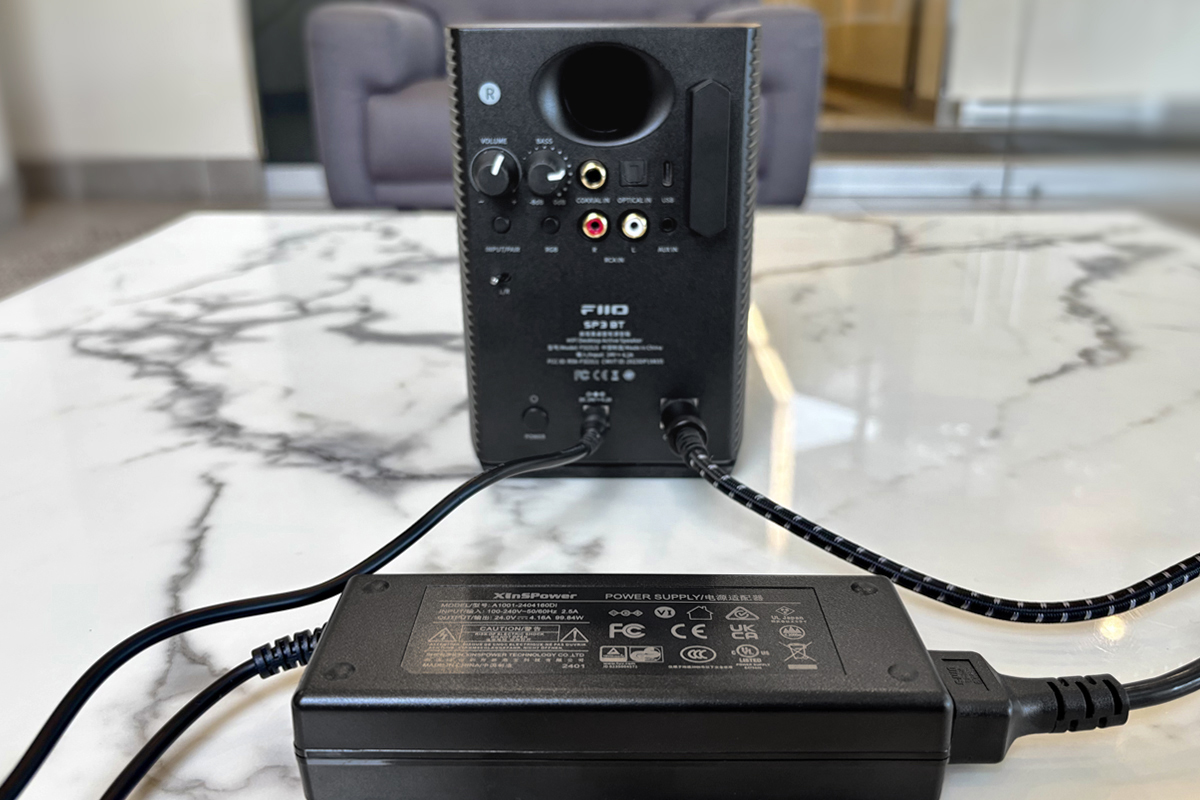
One of the ways FiiO manages to keep the speakers so compact is through the use of an external power brick, which is typical of the computer-audio space. A 24V DC, 4.16A switched-mode power supply (SMPS) is employed, housed in a rugged 1.25″H × 5.75″W × 2.25″D black-plastic enclosure. This is connected using a barrel jack on the end of a 3.9′ cable, which is only long enough to keep the power-supply unit out of sight on the floor if the speakers are on a surface that’s less than 3.9′ in height. Otherwise, the power brick will either need to share space with the speakers or dangle awkwardly somewhere above the floor.
The connection panel on the rear of the primary speaker is comprehensive. Physical inputs include stereo analog RCAs, a 3.5mm auxiliary jack, USB Type‑C, optical S/PDIF (TosLink), and coaxial S/PDIF (RCA). The optical input supports audio up to 24-bit/96kHz, while the USB Type‑C and coaxial inputs handle up to 32/96. This range of inputs provides flexibility for various source components, from computers to digital-audio players to streaming devices. Input selection is strictly manual, and it requires interacting with a small button hidden amongst the cluster of inputs on the rear panel to cycle through the six input modes. Of course, since there’s no remote, switching of inputs cannot be done from across the room.
Bluetooth options are also impressive thanks to a Qualcomm QCC5124 chip with Bluetooth 5.0. The SP3 BT supports a comprehensive suite of Bluetooth codecs: SBC and AAC for universal compatibility, aptX and aptX Low Latency for improved quality and reduced delay, and aptX Adaptive, aptX HD, and LDAC for high-data-rate wireless audio transmission.
The published frequency response is specified as 65Hz–20kHz, ±2dB, suggesting quite usable bass extension for speakers of this size. Unfortunately, there’s no simple way to add a subwoofer to augment deep bass reproduction, with no onboard bass management or subwoofer output included. Next to the volume knob on the rear panel you will find a bass-level control that provides attenuation from 0dB to ‑8dB, useful for adjusting the speakers to different placement scenarios or personal preferences, though I mostly found it unnecessary in my applications.
Setup
Out of the box, setup is straightforward. All necessary cables are included, and the main speaker delivers signal and power to the secondary speaker via an eight-pin DIN cable. The provided cable is 8.5′ long, allowing proper spacing for wide stereo positioning and making it easy to find the best placement on a desk or shelf. The primary speaker can be designated for left- or right-channel playback using the toggle switch on its rear.
When the system is powered on, LED lights softly illuminate the entire perimeter around the bottom of each cabinet, with 24 different colors available for selection via a rear-panel button. This adds subtle RGB accent lighting that will undoubtedly appeal to gamers more than the rest of us. The lights can be turned off if you prefer a more subdued, traditional appearance, but unfortunately the setting doesn’t stick, and you’ll need to turn the lights off each time you use the system. This is a shortcoming to be aware of.
Another negative is that there’s no auto wake-up for after the speakers go into standby mode, which happens after they’ve been idle for around 40 minutes. I was expecting them to wake on signal detection, but that was not the case, and I found I had to reach for the power button if I left the system inactive for too long.
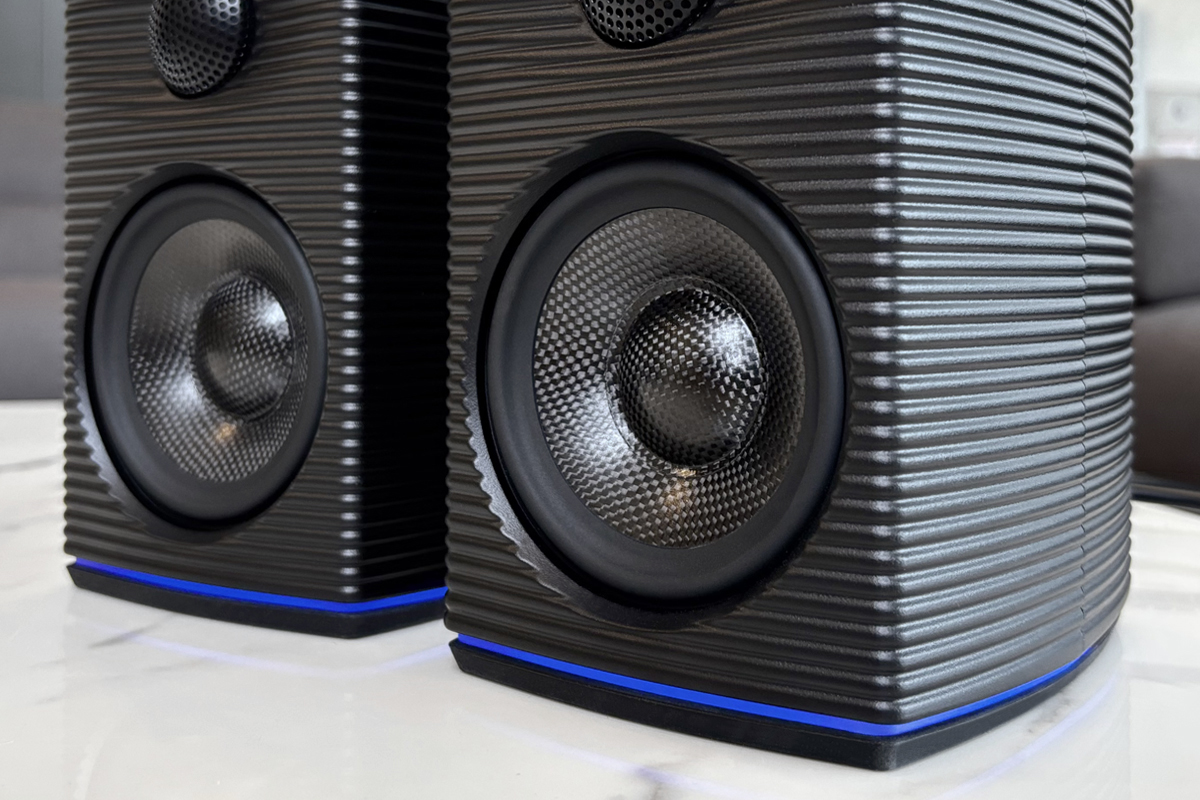
Accessing the internal DAC via coax or optical inputs delivers clean, accurate conversion with no perceptible delay—excellent for both music and media use. However, the USB input is a different story. When I connected either my laptop or iPhone to the USB‑C input, I found that the audio signal was plagued by infrequent glitches, clicks, and dropouts. I was surprised by this, given FiiO’s history and reputation. On the other hand, Bluetooth pairing with my iPhone was immediate, and audio performance using that method was fine, with no wireless-reception issues noted. This speaks well of FiiO’s wireless implementation.
Over extended listening sessions spanning several hours, the SP3 BT demonstrated consistent performance without obvious signs of thermal compression or driver strain. The class‑D amplification ran cool, with only slight warmth detectable after hours of operation. This suggests robust design with adequate thermal management.
App woes
When connected via Bluetooth, the SP3 BT can apparently be fine-tuned using the FiiO Control or FiiO Music mobile apps for iOS and Android. With a common interface across compatible products, these apps provide access to a digital equalizer. I had hoped to explore the ten-band parametric EQ in the FiiO Control app to assess its effectiveness at shaping tonal preferences or addressing room-acoustics issues. Unfortunately, I was unable to get either app to recognize the system, despite having no problem transmitting Bluetooth audio to it from my iPhone.
It seems this issue isn’t unique to me. Researching online, I found numerous reports of the FiiO Control app not working properly on iOS, with users citing persistent connectivity problems, device-detection failures, incomplete feature support, and general instability across product generations and app versions. Common complaints include the inability to connect FiiO devices to the app or control their settings, app crashes, and some users experiencing devices being “bricked” after attempting configuration.
Listening
Fed digitally from my WiiM Mini streamer, the SP3 BT impressed me with a sonic character that is miles beyond what most multimedia and Bluetooth desktop speakers deliver. The die-cast, aluminum-alloy construction imbues the speakers with impressive heft for units in their size class, helping minimize unwanted cabinet vibrations and resonances. With the bass knob set to flat (no attenuation), I found the out-of-box sound to have good presence and definition, with a sound balance that I would liken more to small studio-monitor speakers than traditional hi-fi.
High frequencies were presented with finesse and precision, without pronounced sibilance or harshness. Vocals and speech were very convincing, and brass instruments exhibited good body through the low midrange. Soundstages were presented with adequate width, delivering convincing stereo imaging and instrument separation. The upper midrange occasionally exhibited a slight emphasis that made some recordings (and snare drums in particular) sound a touch forward or bright, though this was a relatively minor qualm. Listeners who enjoy an engaging, highly detailed presentation might actually prefer this balance.
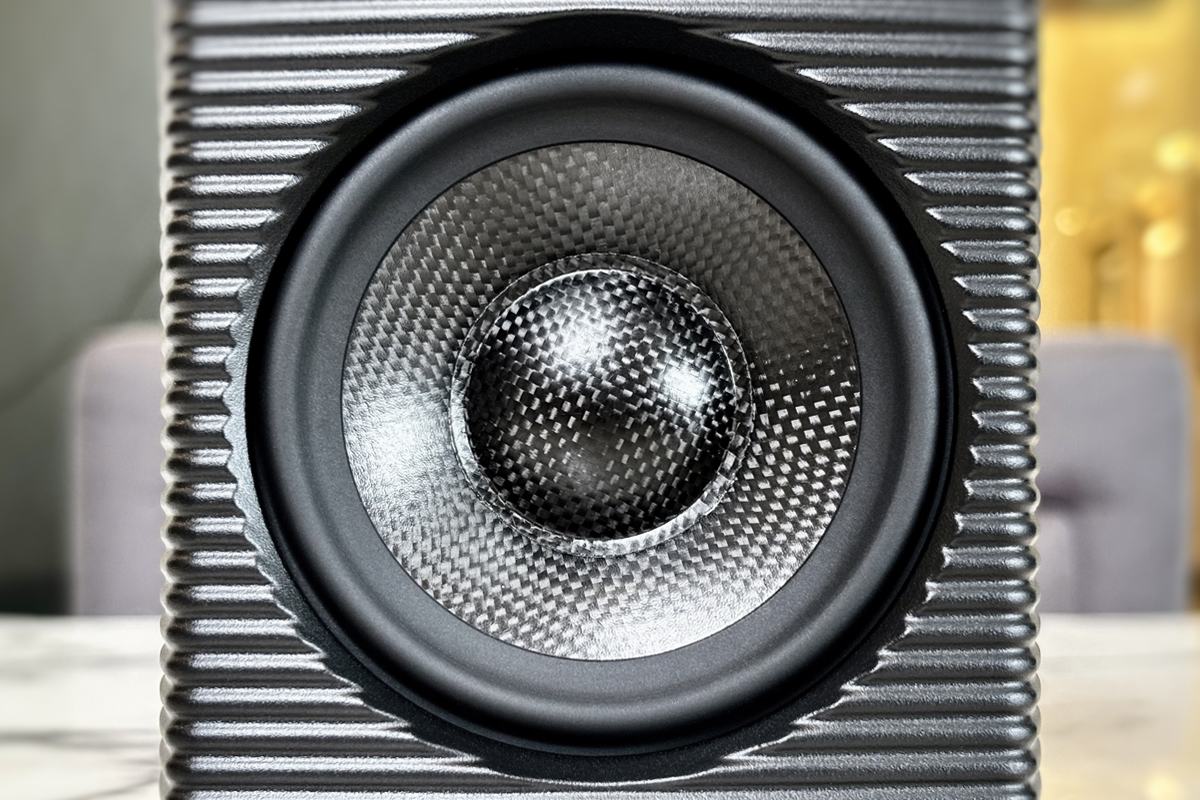
Bass output, though obviously limited, was tight and musical down to about 70Hz, lending sufficient weight to rock, pop, and acoustic genres at reasonable listening levels in a domestic space. At higher volumes, the speakers held their composure with little distortion. Bass notes had good definition and control, avoiding the bloated, boomy character that can afflict small ported designs. The ports did produce noticeable chuffing at elevated volume levels, though that was only with very bass-heavy material.
The low-frequency performance, while not extending deep, was quite impressive for the size of the system. It should go without saying, however, that the deepest fundamental notes were missing, and bass in general lacked the fullness and weight you’d find with larger systems. This is not surprising given the speakers’ compact size and the 65Hz lower limit of their specified frequency response, but it’s worth noting for those who prioritize deep bass reproduction.
Subjectively, I found that the SP3 BT performed very well when set up with speakers 5′ apart and front baffles 16″ from the front wall of my 11′ × 8′ acoustically treated den. From my first listen, I was impressed with the sound these little speakers put out. Of course, they will play reasonably loud in nearfield desktop applications without strain, but even in a room like my den, they produced plenty of useful output.
What particularly stood out was the soundstaging. Despite the speakers’ modest size and nearfield placement, the SP3 BT system created a surprisingly expansive three-dimensional soundstage. The performance extended well beyond the physical boundaries of the speakers. Individual instruments occupied precisely defined locations within this sonic landscape, and the sense of air and space around each performer was palpable. This level of imaging precision is unusual for speakers in this category.
The instrumentation in Sam Greenfield’s “Chips & Dip (Extra Chunky)” from Worst of Sam Greenfield (24‑bit/44.1kHz FLAC, ONErpm / Qobuz) is reminiscent of big-band jazz, featuring a dynamic mix of saxophones, guitar, bass, and drums. The alto sax, played by Greenfield, carries much of the melodic content, while tight brass arrangements support and punctuate the piece. The tightness of the arrangement was conveyed by the SP3 system with clarity and precision, delivering the song’s sophisticated, energetic groove very nicely.
The tune draws on jazz and funk, with rapid modulations that alternate between complex, syncopated ensemble passages and solo breaks—especially for the sax—as it maintains its momentum and spotlights the technique of individual musicians. I heard clear separation between instruments, particularly within the brass and rhythm sections. The FiiO system conveyed the song’s live feel and highlighted the improvisational interplay while ensuring every musical line was clear, resulting in a vibrant, highly coherent, and punchy sound.
The Fearless Flyers are renowned for minimalist, groove-centric arrangements, and “Thunderbirds” from The Fearless Flyers IV (24/48 FLAC, Vulf Records / Qobuz) is a showcase of their signature approach. The band’s sound builds around the interplay of Joe Dart’s syncopated bass playing with dual guitar parts, along with a no-frills drum kit that prioritizes kick, snare, and hi‑hat. This stripped-down palette allows space for each note to shine, giving the arrangement an air of effortless precision that the SP3 BT handled brilliantly.
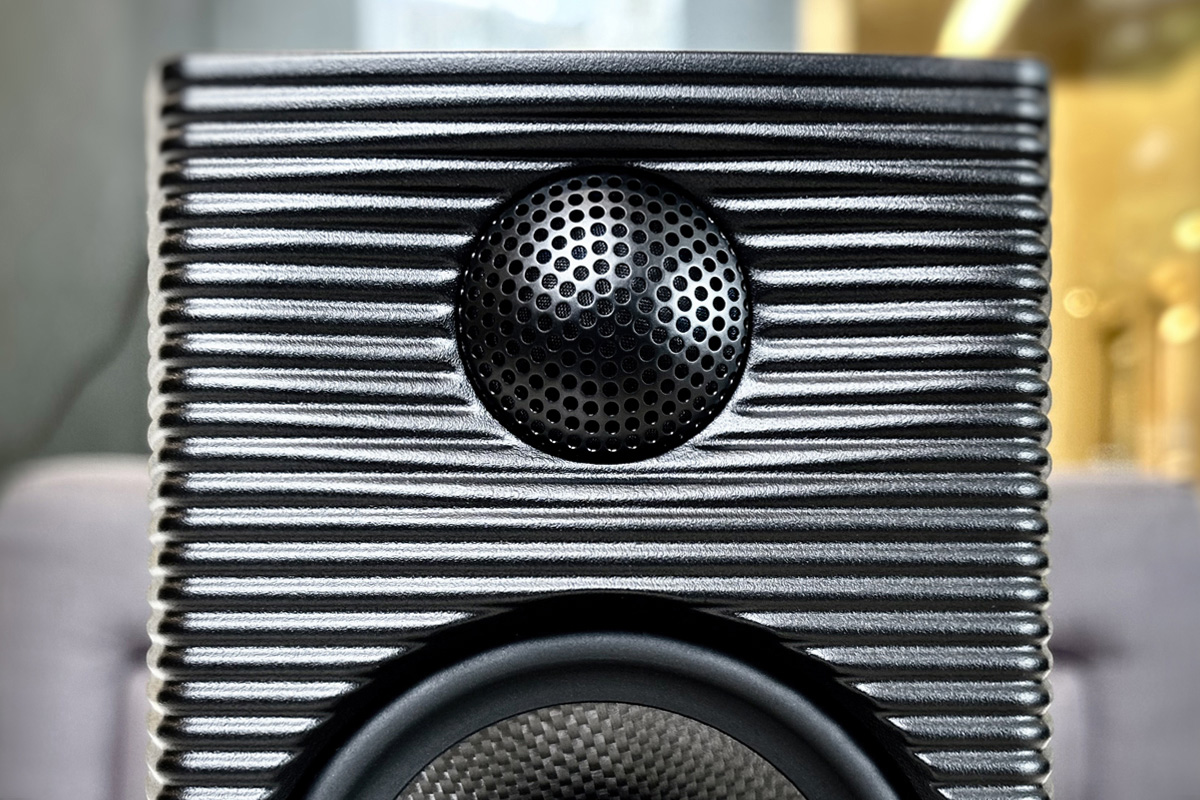
The track revolves around tight rhythmic synchronization, with spatial separation between melodic lines. The song’s structure allows for melodic motifs to cycle and evolve, creating a sense of drive and anticipation. The intentional simplicity sounded both meticulously composed and easygoing through the FiiO system. The whole mix reflects the Flyers’ ethos: maximum impact through radical minimalism—with every instrument’s character distinctly presented by the little SP3 BT speakers.
“Simmer” by Hayley Williams, from Petals for Armor (24/96 FLAC, Atlantic Records / Qobuz), demonstrates a creative blend of traditional rock instrumentation and modern electro-pop production. The foundation includes bass guitar, electric guitar, and a contemporary drum kit, accented by richly textured keyboard layers and synthetic percussion. Notably, Williams integrates her own vocal effects, like breaths, hums, and vocalizations, as melodic and percussive elements, infusing the track with personality and intimacy. These vocal parts in particular were delivered with impressive clarity by the 3.5″ midrange-woofers, though there was some apparent modulation from the bass instruments during busy passages.
RJD2’s “20 Grand Palace” from The Fun Ones (24/96 FLAC, RJ’s Electrical Connections / Qobuz) opens with a sophisticated fusion of clarinet and strings, immediately distinguishing itself for having somewhat uncommon instrumentation for contemporary funk. After this elegant introduction, the song builds into a horn-driven groove, supported by punchy drums and a wealth of sample-based textures. RJD2’s signature use of string and horn arrangements adds catchiness, complementing the rhythmic backbone of the piece.
Song structure is designed to surprise—quiet, suspenseful beginnings burst into grooves marrying sophisticated harmonic progressions with irresistible rhythms. String lines and horn stabs are woven throughout, creating call-and-response moments and layering complexity atop infectious beats. The mixing maintains a lively, open feel, accentuating each instrumental voice and constructing a danceable, cinematic soundscape.
The SP3 BT’s speakers demonstrated impressive dynamic capability for their size, delivering convincing contrast between the loud passages and quieter interludes. Synthesizer bass pulses revealed the SP3 BT’s limitations in the lowest frequencies, however. While the bass was clearly present and well-controlled, with good definition and timing, it lacked the physical impact and room-pressurizing quality that larger speakers or a subwoofer would provide.
Comparison
To provide context for the SP3 BT’s performance, I ran the FiiO system alongside my old Tannoy PBM 5II passive two-way bookshelf monitors, driven by the Eversolo Play (no equalization applied), level matched using a -10dBFS test track to give me 75dB between both sets of speakers. The coaxial output from the Play was used to feed the SP3’s digital input, and switching was accomplished through the Play’s UI. The Tannoys feature larger 5″ midrange-woofers with 0.75″ polyamide-dome tweeters, crossed over at 2.6kHz, all housed in substantially bigger cabinets that stand just under 12″ tall.
Surprisingly, the larger Tannoys fell flat in this comparison. The FiiOs actually sounded more “hi-fi,” with tighter, more impressive bass and better spaciousness. I even dialed the bass control back a little on the FiiO system to make the comparison fairer! The SP3 BT also delivered superior detail retrieval and imaging precision. The FiiO system resolved finer textural details in acoustic instruments and vocal performances, creating a more transparent presentation. The soundstage thrown by the SP3 BT was wider and more precisely focused, with individual instruments occupying more clearly defined locations.
Tonally, the Tannoy PBM 5IIs presented a slightly warmer overall balance with more mid-bass energy, but sounded boxy when compared directly to the SP3 BT, which felt slightly brighter and more forward in the upper midrange, but also fuller in the low frequencies. The sound of the FiiO system was more cohesive and appealing to my ears.
This comparison is a testament to the engineering that FiiO has put into these little speakers, amply demonstrating the advantages that modern active systems have over traditional passive systems.
Conclusion
FiiO’s SP3 BT system is an impressive achievement in desktop speaker design, delivering sound quality that exceeds expectations for its size and price.
The carbon-fiber midrange-woofers provide accurate midrange response with low distortion, while the silk-dome tweeters are smooth and extended without harshness. Soundstaging and imaging precision are excellent, creating an expansive and focused presentation that rivals far more expensive systems.
Connectivity is flexible, with analog, digital, and wireless inputs supporting high-resolution audio formats and advanced Bluetooth codecs. The SP3 BT integrates into virtually any system, though the USB input is best avoided based on my findings. The parametric EQ via FiiO’s mobile apps adds useful tuning capability—if you can get the apps working.
The primary limitation is physical: 3.5″ woofers in compact cabinets cannot reproduce deep bass with the authority of larger speakers. What bass is present remains musical and engaging, but those prioritizing sub-bass extension should look elsewhere. Adding a subwoofer isn’t as straightforward as it could be with this system.

These speakers excel in desktop nearfield listening, where their compact size becomes an asset, and their detailed presentation shines at short distances. They would also work well in small rooms with space constraints, or as secondary systems for bedrooms and offices. Wireless capability makes them ideal when cable runs are problematic or source devices change frequently.
At US$349, the SP3 BT sits in a competitive market segment, but few rivals match its combination of sonic performance, build quality, and connectivity. Competitors either cost more, offer fewer connections, or lack the SP3 BT’s resolution and imaging capabilities. The SP3 BT occupies a sweet spot: genuine high-fidelity performance in a compact, attractive, and highly functional package. It demonstrates how much can now be achieved in a desktop-friendly form factor.
For those seeking desktop audio that doesn’t compromise on sound quality while maintaining reasonable cost and footprint, the SP3 BT warrants serious consideration. Users who don’t need Bluetooth or digital inputs can save $50 with the standard SP3, but for most, the SP3 BT’s added flexibility justifies the modest premium.
. . . AJ Wykes
Associated Equipment
- Sources: Apple MacBook Pro (2019), iPhone 15, WiiM Mini
- Speakers: Tannoy PBM 5II
- Streaming amplifier: Eversolo Play
FiiO SP3 BT active desktop speaker system
Price: US$349, CA$499.99, £319, €379
Warranty: One year
Guangzhou FIIO Electronics Technology Co., Ltd.
No.21 Longliang Road, Xialiang Village
Guangzhou City, China, 510540
Email:
Website: www.fiio.com





